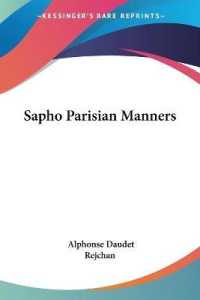- ホーム
- > 洋書
- > 英文書
- > Literary Criticism
Full Description
Narrative Structure and Reader Formation in Lady Mary Wroth's Urania offers the first systematic formal and thematic analysis of Wroth's Urania in its historical context and explores the structural means by which Wroth fashions her readership. The book thus has a dual focus, at once on narrative art and reader formation. It makes two original claims, the first being that the Urania is not the unorganized accumulation of stories critics have tended to present it as, but a work of sophisticated narrative structures i.e. a complex text in a positive sense. These structures are revealed by means of a circumspect narratological analysis of the formal and thematic patterns that organise the Urania. Such an analysis furthers our understanding of the reading strategies that Wroth encourages. The second claim is, then, that through the careful structuring of her text Wroth seeks to create her own ideal readership. More precisely, the formal and thematic structures of the Urania engage with readers' expectations, inviting them to reflect on prominent thematic issues and respond to the text as what early modern prefaces term "good" readers. Combining narratological methods with a generic perspective and taking into account the work of book historians on early modern reading practices, this monograph provides a new approach to the Urania, supplementing the typically gender- or (auto)biographically-oriented interpretations of the romance. Moreover, it contributes to the study of early modern (prose) narrative and romance and exemplifies how historically contextualised narratological analysis may yield new insights and profit research on reading strategies.
Contents
Table of Contents
List of Tables and Figures
Acknowledgements
Introduction
Chapter 1: Entering the Urania through the Frontispiece
Abundance versus Lack
Reading the Lack of Prefatory Material
Reading the Abundance of the Frontispiece
Conclusions
Chapter 2: Narrator and Narratee: Guidance, Critical Sympathy and Discretion
The Gender-Neutral Narrator
Textual Guidance: Orientation and Cohesion
Sympathy and Criticism
The Art of Narration and Discretion
The Narratee
The Published First Part vs. the Manuscript Continuation
Chapter 3: Narrative Levels and Strands: Emotional Immediacy, Proliferation and the Promise of Closure
Narrative Levels
Narrative Strands
The Published First Part vs. the Manuscript Continuation
Chapter 4: Space and Displacements: Multiple Reading Modes and Tensions of Meaning
Reading Space and Settings
Spatial Movements and Travel Patterns
Chapter 5: Recurring Themes and Plots: Textually Inscribed Reflection and Debate
Recurring Themes and Plots
The Quest for Identity
Conquering and Defending a Throne
Love Matters
Courtship
Male Infidelity
Marriage
Supporting and Contrasting Inset Tales
Conclusion: Interpretive Freedom vs. Closure - The Story of Drusio and Isabella
Appendix
Bibliography
Primary Sources
Secondary Sources
Index








